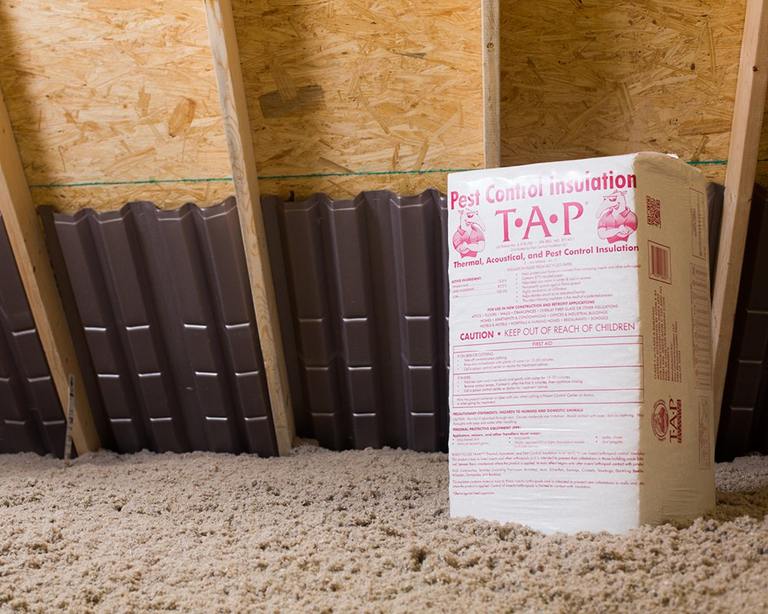Insulation-Based Pest Prevention vs. Traditional Insulation: A Comprehensive Comparison
Published: March 25, 2025

Introduction
When it comes to insulating your home, the choice of material can significantly impact energy efficiency, comfort, and even pest control. While traditional insulation materials like fiberglass and cellulose have long been the standard, Thermal Acoustical Pest Control (TAP®) insulation is gaining popularity due to its multi-functional benefits. This article provides a detailed comparison of insulation-based pest prevention versus traditional insulation, highlighting their differences in R-value, installation methods, benefits, and integration with pest control strategies.
Understanding R-Value: A Key Factor in Insulation Performance
R-value measures the thermal resistance of an insulation material, indicating how effectively it prevents heat transfer. The higher the R-value, the better the insulation.
According to research published by the U.S. Department of Energy, homes with higher R-value insulation see reduced energy costs and improved thermal regulation. Proper insulation not only helps maintain indoor temperatures but also contributes to lower energy consumption throughout the year. TAP® insulation provides comparable, if not superior, R-values to traditional options while offering significant pest-repelling benefits.
Installation Methods: Traditional vs. TAP®
Traditional Insulation
Traditional insulation comes in various forms, including batt, blown-in, and spray foam. Installation typically involves:
- Cutting and fitting batts between wall studs or attic joists
- Blowing in loose-fill cellulose or fiberglass
- Spraying foam insulation in cracks and gaps for a tighter seal
- Installing vapor barriers to control moisture and prevent mold growth
TAP®
TAP® insulation is a blown-in cellulose-based material treated with boric acid, a natural pest deterrent. The installation process includes:
- Using a specialized machine to distribute the material evenly across attic floors
- Creating a dense, seamless barrier that reduces air leaks
- Providing continuous coverage without gaps, unlike traditional batt insulation
- Forming a protective layer that discourages pests from nesting within the insulation material
Unlike batt insulation, which can leave gaps if not installed correctly, TAP® ensures complete coverage and a more effective thermal seal while adding the added benefit of pest prevention.

Benefits of Insulation-Based Pest Prevention Over Traditional Options
While both insulation types provide thermal benefits, insulation-based pest prevention offers unique advantages:
1. Built-In Pest Control
Treated with boric acid, an EPA-registered pesticide, TAP® insulation helps control common household pests such as:
- Cockroaches
- Termites
- Ants
- Silverfish
- Beetles
Because pests cannot develop resistance to boric acid, this insulation offers long-term protection without needing frequent chemical treatments.
2. Superior Energy Efficiency
Seamless installation reduces thermal gaps and air leaks, resulting in:
- More consistent indoor temperatures
- Reduced HVAC workload
- Lower energy bills
- Better performance during extreme summer and winter conditions
Since air leaks are a major cause of energy loss in homes, TAP® insulation’s ability to form a complete barrier significantly improves efficiency.
3. Improved Soundproofing
The dense cellulose composition provides better acoustical control, reducing noise from outside and between rooms. Homeowners in busy neighborhoods or those who work from home can benefit from a quieter indoor environment.
4. Eco-Friendly Composition
Made from 87% recycled paper, TAP® insulation is an environmentally friendly alternative to fiberglass, which contains synthetic materials. This makes it a great choice for homeowners looking to reduce their carbon footprint while improving their home’s insulation performance.
5. Fire Resistance
Since it is treated with borates, TAP® insulation also has fire-retardant properties. This adds an extra layer of protection, slowing down the spread of flames in the event of a fire.

How Insulation-Based Pest Prevention Works Alongside Traditional Pest Control
While TAP® insulation provides substantial passive pest control, it is not a replacement for a comprehensive pest management plan. Combining it with professional pest control services can only enhance home protection. Here’s how:
- Prevention of Pest Entry – The material deters pests that attempt to burrow through insulation, reducing infestations before they start.
- Long-Term Pest Management – Routine pest control services target pests not affected by borate-treated insulation, such as rodents and bedbugs.
- Comprehensive Coverage – Works best in attics, but pest control professionals can treat other areas like basements and walls where pests may infiltrate.
- Reduces Need for Chemical Treatments – Since boric acid is already present, homeowners may experience fewer pest infestations, reducing reliance on pesticides over time.
- Better Air Quality – By preventing pest infestations, this insulation helps improve indoor air quality by reducing allergens from pest droppings and dander.

Conclusion
For homeowners seeking both energy efficiency and pest control benefits, insulation-based pest prevention stands out as a superior choice. With its high R-value, seamless installation, and built-in pest resistance, TAP® insulation provides a strong alternative to traditional insulation while working in tandem with professional pest control services for maximum home protection.
For those looking to improve their home’s insulation while taking proactive pest control measures, TAP® insulation is a smart investment that pays off in energy savings, comfort, and peace of mind.